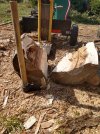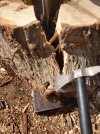- Joined
- Mar 19, 2018
- Messages
- 4,378
As I focus again on the mindless task of prepping firewood, I can't help but contemplate what others keep next to their splitter for those stubborn stringy pieces.
All of the old timers I've split wood for over the years have at least had a hatchet nearby, and usually an axe as well.
For me it's my imacasa round eye and an old Emerson cqct that I ground the spike on to act as a pick (that part of the project still meeds work, it doesn't exactly do the greatest on gnarly hardwoods). Since a large number of the removals we're called on to do in any given year are huge yard trees, it's helpful having a something or 2 nearby to finish difficult splits when the time comes to process firewood. This saves me muscling huge rounds in circles on the splitter, I can just flip them over and give the sides a whack.
Or I can just smack the stubborn stringy stuff without moving the round at all.

It goes without saying that occasionally these can be he-manned apart, but as an edged tool enthusiast I try not to leave any opportunities on the table.
I'm curious to hear and see what the denizens of the axe forum keep near to hand when processing wood.
All of the old timers I've split wood for over the years have at least had a hatchet nearby, and usually an axe as well.
For me it's my imacasa round eye and an old Emerson cqct that I ground the spike on to act as a pick (that part of the project still meeds work, it doesn't exactly do the greatest on gnarly hardwoods). Since a large number of the removals we're called on to do in any given year are huge yard trees, it's helpful having a something or 2 nearby to finish difficult splits when the time comes to process firewood. This saves me muscling huge rounds in circles on the splitter, I can just flip them over and give the sides a whack.

Or I can just smack the stubborn stringy stuff without moving the round at all.

It goes without saying that occasionally these can be he-manned apart, but as an edged tool enthusiast I try not to leave any opportunities on the table.
I'm curious to hear and see what the denizens of the axe forum keep near to hand when processing wood.
